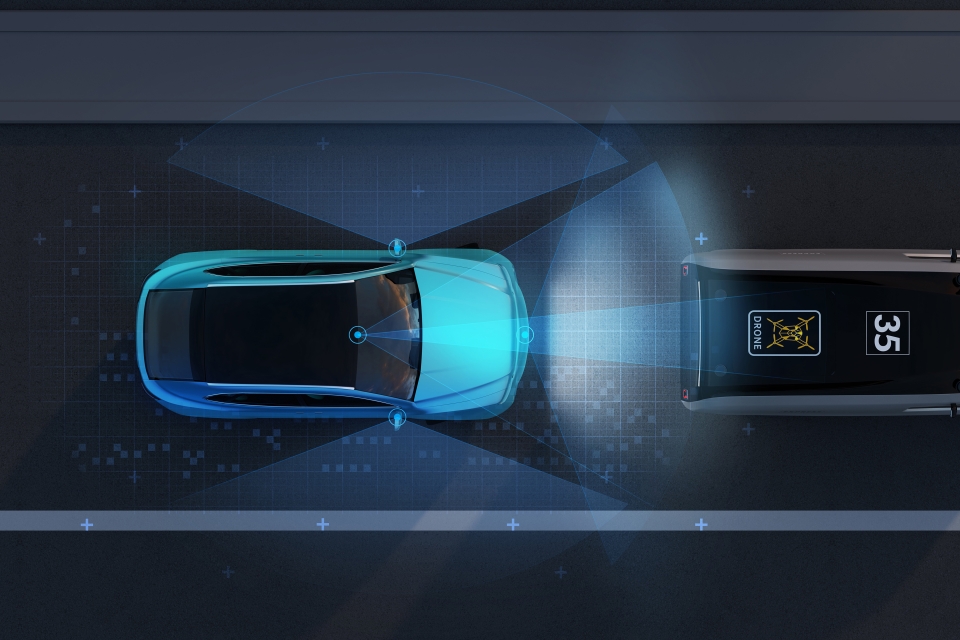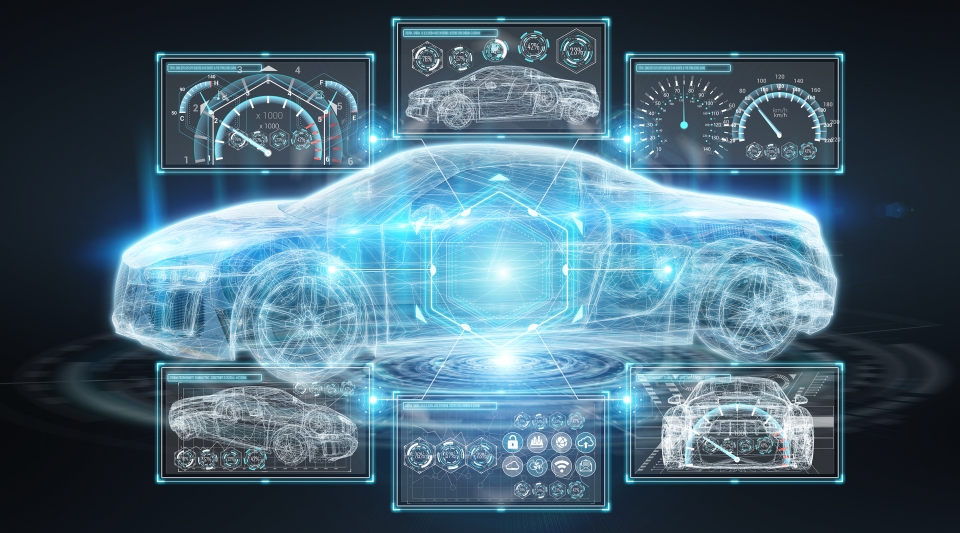Navigating The Road Ahead with Autonomous Tech
2024/03/22 | By CENS
With the growing popularity of the trend towards liberating human drivers from the steering wheel during the entire driving process, the research and development of autonomous driving technologies have gained heightened attention from governments, industries, and research institutes. This phenomenon is particularly evident in recent years, an era marked by unprecedented progress in the ICT industry.
The Eyes and Ears of Tomorrow's Cars
According to Teng Wan-Chun, the director of the research and development division at the Automotive Research & Testing Center (ARTC), one of the key drivers for advancing tomorrow's autonomous vehicles is Advanced Driver Assistance Systems (ADAS). ADAS employs autonomous technology like sensors to detect, recognize, and track various objects encountered in the driving environment.
Teng outlined the four main types of sensors currently in use, each with its own advantages and drawbacks. The "camera" sensor, with its extensive history, offers a mature technology at a reasonable price point. However, its reliability diminishes in adverse weather conditions, and its recognition ability is influenced by factors like frame rate and image quality, demanding significant computational power. Noteworthy contributors to camera sensor technology in Taiwan include Whetron Electronics Co., Ltd., oToBrite Electronics, Inc., Chimei Motor Electronic Co., Ltd., HPB Optoelectronics Co., Ltd., and LITE-ON Technology Corporation.
Similarly, "Lidar" sensors are computationally intensive and relatively costly as they rely on transforming environmental data into a point cloud for detection. While Lidar excels in determining object distances and providing three-dimensional location and intensity data, it struggles with object classification. Initially utilized in land surveying and interior building scanning, Lidar has since expanded into various applications.
Another costly sensor is the "radar," prized for its ability to measure speed and distance. However, radar sensors are sensitive to metallic reflections from objects such as guardrails, railings, and metal joints, requiring noise interference reduction to ensure accuracy. Among the prominent suppliers in the "radar" sensor domain are Cubtek Inc., Universal Microelectronics Co., Ltd. (UMEC), Alpha Networks Inc., and Wistron NeWeb Corp.
On the other hand, "ultrasound" sensors are suitable for short-range detection and are more affordable compared to other options. Despite their relatively slow reaction time, ultrasound sensors are widely available in Taiwan and commonly used for car reversing and parking assistance.
To ensure the proper functioning of autonomous driving systems in facing complex road scenarios, Teng emphasized the need to address various challenges. These include situations such as the convergence of vehicles in roundabouts, roads under repair, and other demanding road conditions, as well as obstacles presented by adverse climate conditions like rain, fog, night, and backlighting. These factors can potentially impair the effectiveness of ADAS sensors, rendering them "blind." Teng suggested that a viable approach to overcome these challenges is the implementation of a "sensor fusion" design, currently undergoing extensive research and showing rapid progress.

Tech Innovation Race Heats Up
According to an ARTC report, international automobile manufacturers have been aggressively introducing autonomous technology. For example, in 2023, Mercedes-Benz imported its SAE Level 3 autonomous system, "DRIVE PILOT," to California and Nevada, USA. This move signifies the company's cars can legally take over driving duties outside Europe for the first time. Additionally, in collaboration with Bosch, the highly automated parking system "AVP (Automated Valet Parking)" has been approved for use in the P6 parking garage run by APCOA at Stuttgart Airport. This marks the world's first highly automated driverless parking function to reach Level 4 and be officially approved for commercial use.
Other major brands are also staying abreast of advancements in autonomous driving technology. For instance, BMW has emerged as the first German manufacturer to introduce a high-speed (130km/h) autonomous driving system, featuring its own HERE high-precision map. This system is anticipated to be integrated into its Level 3 automated driving Series 7 model by 2024. Similarly, in Korea, vehicles such as the Genesis G90 and the Kia EV9 come equipped with the Highway Driving Pilot (HDP) function, showcasing Level 3 autonomous driving technology.
In tandem with global advancements in autonomous driving technology, Taiwan is also making significant investments in fostering its maturity. According to Teng, the Ministry of Economic Affairs (MOEA) plays a pivotal role in driving the industry forward. This includes promoting the establishment of ARTC, which conducts feasibility testing and serves as a governmental think tank in the autonomous driving field. Moreover, through research on existing international regulations, the Ministry of Transportation and Communications is working on enacting rules and regulations concerning autonomous vehicles for on-road usage. They enact detailed requirements for autonomous systems and establish safety guidelines for autonomous shuttles to provide industry reference ahead of formal regulations. The Ministry of the Interior supports map data provision, which is crucial for autonomous driving, while the National Science and Technology Council is establishing sandblast tests for autonomous driving systems.
In a collaborative effort across agencies, ARTC launched its fleet operation of self-driving buses on December 8th, 2023. This groundbreaking system, honored with the 2023 AutoTech Breakthrough Awards for "Autonomous Driving Solution of the Year," allows a self-driving or human-driven bus to lead another self-driving bus via an inter-vehicle network, streamlining passenger transport. Currently, the system is operational in the ARTC park and undergoing test runs in downtown areas.
According to Dr. Hsu Tsung-Ming, who is mainly responsible for the project at ARTC, there are three primary technical challenges that must be addressed in developing this technology. Firstly, achieving precise vehicle positioning is crucial, with self-driving vehicles requiring accuracy within 20 or 30 centimeters. However, obstacles such as viaducts can disrupt GPS signals. To overcome this, Hsu indicates employing multiple positioning technologies simultaneously.
The second challenge involves navigating through chaotic urban traffic, including issues like jaywalking and illegal parking, as well as the potential presence of regular cars intermingling with the fleet of self-driving buses. Addressing this requires continuous algorithm refinement and real-world testing outside the controlled environment of the ARTC.
Finally, ensuring stable inter-vehicle communication is essential. ARTC utilizes C-V2X technology specifically designed for this purpose, along with integrating 4G/5G internet connectivity to maintain a stable connection between the buses, even in areas with poor communication quality. Additionally, the buses can automatically switch channels to mitigate communication disruptions.

The Inspection Tour
Furthermore, to better showcase ARTC's technical prowess, the organization resumed its annual "ARTC Inspection Tour" in 2023 after a three-year hiatus due to the COVID-19 pandemic. The tour is designed to highlight the latest advancements in advanced driver assistance systems (ADAS).
During the Inspection Tour, ARTC utilizes an "Autonomous Driving Robot" to test its lane departure warning (LDW) and lane keep assistance (LKA) systems. For LDW, a speed of 72±1 km/h and a side velocity of 0.5 m/s were employed, while for LKA, speeds of both 0.5 m/s and 0.8 m/s were utilized on its proving ground. The test provides perspectives from aerial, onboard, and car window views, along with real-time data display on a computer. The results of the test were significant.
In recent years, ARTC has dedicated considerable effort to cultivating partnerships with various certification organizations and vehicle manufacturers. Its primary objective is to act as a catalyst for internationalization, aiding practitioners in expediting time-to-market and reducing development costs, all in pursuit of advancing self-driving technology.

